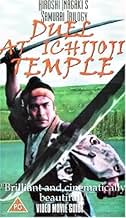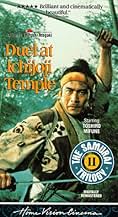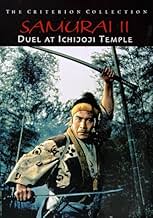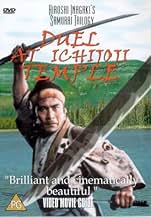VALUTAZIONE IMDb
7,3/10
7266
LA TUA VALUTAZIONE
Aggiungi una trama nella tua linguaMusashi Miyamoto returns to Kyoto after years of absence. After a series of fights against the Yoshioka School, he challenges its master to a duel.Musashi Miyamoto returns to Kyoto after years of absence. After a series of fights against the Yoshioka School, he challenges its master to a duel.Musashi Miyamoto returns to Kyoto after years of absence. After a series of fights against the Yoshioka School, he challenges its master to a duel.
- Regia
- Sceneggiatura
- Star
Recensioni in evidenza
Being the middle film of a trilogy, Duel at Ichijoji Temple thankfully came with a lot more battle sequences than the first film, and had more finesse in its swordplay since our legendary heroic character Takezo (Toshiro Mifune) is now a skilled swordsman, but yet to put into practice many aspects of Bushido, and often criticized in the manner in which he finishes off his opponents because of his innate brute strength and force.
But I guess when you're top dog, criticism comes part and parcel, and in his warrior pilgrimage in discovery of skill and self, we see how he further develops, though at time I felt that the story utilized a cheat sheet just like the first film, where priest Takuan (Kuroemon Onoe) locked him in a castle with plenty of books. Here, while Takezo is in hiding, he spends plenty of time indoors under the patronage of Lady Yoshino (Michiyo Kogure), a courtesan who would inculcate some compassion into the gruff man's life - while he looks refined on the outside, his ambition and reputation continue to earn him no favours, especially since he had issued a challenge to the Yoshioka School.
As a middle film, it expanded the mythology, and further developed the characters who made teasing appearances in the first one. For instance, the young man who was smitten by Akemi (Mariko Okada) turns out to be none other than the leader of the Yoshioka School, Seijuro Yoshioka (Akihiro Hirata), who in a fit of envy began to violate Akemi, taking his ineptness onto a helpless girl. Such are incidents that make the character a little revolting, and the members of his school showcased to be nothing more than mere bullies to the townsfolk, as well as constantly sucking up to Seijuro by shielding his incompetence from the real world.
The villains in this installment turn out to be more formidable than the thugs and brigands that Takezo had to deal with earlier. In fact, the first duel was a battle with an opponent using a chain-and-sickle, in compensation for the lack of a swordfight as a climax in the first film. Unfortunately I found this to be mildly exciting, as the full screen presentation only allowed for that fatal blow to be delivered off screen. The middle duel with Denshichiro Yoshioka was also somewhat of a let down given the buildup, because it only allowed a brief clashing of the weapons, before director Hiroshi Inagaki decided to cut away to a song! It felt like a little short-change, though the result of the match was made known indirectly later.
And the expansion of the characters here only made the story richer. Familiar faces like Takezo's lover Otsu (Kaoru Tachigusa) returns to pine a lot more for him after 3 years of waiting, while her ex-fiancé Matahachi (Sachio Sakai) degenerates worse in character, into a good for nothing liar and a cheat, married to Akemi's scheming mom Oko (Mitsuko Mito). We also get introduced to sword polisher Hanomi (Ko Mihashi) who's supposed to play an influential role in swaying Takezo's mindset, though the narrative here didn't allow too much of that on screen, deflecting it towards Lady Yoshino, for yet another romantic entanglement, where the female characters are all weak in their knees in Takezo's manly presence.
But the most important character introduced in the film would be Kojiro Sasaki (Koji Tsuruta), the eventual nemesis of Takezo's, but you've got to wait until the next film to see them do battle. Here, Kojiro's like the predator, slowly studying and stalking his prey. We know little of his background, apart from his certification of swordsmanship, and his cool, collected demeanour as opposed to Takezo's brash emotions, so that already sets him up to be mile apart as a strong adversary in time to come. So far he has played things in quite a gentlemanly way, refusing to take cheap shortcuts, patiently and probably egoistically waiting for Takezo to attain more skills, before bringing down a powerful opponent.
Again the technical aspects of this DVD presentation left much to be desired, especially in the night or dawn battle scenes. It's not digitally remastered, so these scenes become really dark and marred the enjoyment of many outdoor fights, especially the titular one where Takezo goes up against 80 opponents, and learns for a start that evading battle may not be so bad an option, especially when one is severely outnumbered due to a sickening, dishonourable scheme to turn tables. I would have wished for a better presentation so that it would not detract your attention to pops and cackles, or unintentional hues to come and stain the picture quality.
Duel at Ichijoji Temple ended just like how it began, with Takezo continuing his journey to seek bushido-enlightenment. It wrapped up some of the life journeys and lessons learnt by the protagonist in this episode, and sets it all up for the climax to be in the last installment of the trilogy.
But I guess when you're top dog, criticism comes part and parcel, and in his warrior pilgrimage in discovery of skill and self, we see how he further develops, though at time I felt that the story utilized a cheat sheet just like the first film, where priest Takuan (Kuroemon Onoe) locked him in a castle with plenty of books. Here, while Takezo is in hiding, he spends plenty of time indoors under the patronage of Lady Yoshino (Michiyo Kogure), a courtesan who would inculcate some compassion into the gruff man's life - while he looks refined on the outside, his ambition and reputation continue to earn him no favours, especially since he had issued a challenge to the Yoshioka School.
As a middle film, it expanded the mythology, and further developed the characters who made teasing appearances in the first one. For instance, the young man who was smitten by Akemi (Mariko Okada) turns out to be none other than the leader of the Yoshioka School, Seijuro Yoshioka (Akihiro Hirata), who in a fit of envy began to violate Akemi, taking his ineptness onto a helpless girl. Such are incidents that make the character a little revolting, and the members of his school showcased to be nothing more than mere bullies to the townsfolk, as well as constantly sucking up to Seijuro by shielding his incompetence from the real world.
The villains in this installment turn out to be more formidable than the thugs and brigands that Takezo had to deal with earlier. In fact, the first duel was a battle with an opponent using a chain-and-sickle, in compensation for the lack of a swordfight as a climax in the first film. Unfortunately I found this to be mildly exciting, as the full screen presentation only allowed for that fatal blow to be delivered off screen. The middle duel with Denshichiro Yoshioka was also somewhat of a let down given the buildup, because it only allowed a brief clashing of the weapons, before director Hiroshi Inagaki decided to cut away to a song! It felt like a little short-change, though the result of the match was made known indirectly later.
And the expansion of the characters here only made the story richer. Familiar faces like Takezo's lover Otsu (Kaoru Tachigusa) returns to pine a lot more for him after 3 years of waiting, while her ex-fiancé Matahachi (Sachio Sakai) degenerates worse in character, into a good for nothing liar and a cheat, married to Akemi's scheming mom Oko (Mitsuko Mito). We also get introduced to sword polisher Hanomi (Ko Mihashi) who's supposed to play an influential role in swaying Takezo's mindset, though the narrative here didn't allow too much of that on screen, deflecting it towards Lady Yoshino, for yet another romantic entanglement, where the female characters are all weak in their knees in Takezo's manly presence.
But the most important character introduced in the film would be Kojiro Sasaki (Koji Tsuruta), the eventual nemesis of Takezo's, but you've got to wait until the next film to see them do battle. Here, Kojiro's like the predator, slowly studying and stalking his prey. We know little of his background, apart from his certification of swordsmanship, and his cool, collected demeanour as opposed to Takezo's brash emotions, so that already sets him up to be mile apart as a strong adversary in time to come. So far he has played things in quite a gentlemanly way, refusing to take cheap shortcuts, patiently and probably egoistically waiting for Takezo to attain more skills, before bringing down a powerful opponent.
Again the technical aspects of this DVD presentation left much to be desired, especially in the night or dawn battle scenes. It's not digitally remastered, so these scenes become really dark and marred the enjoyment of many outdoor fights, especially the titular one where Takezo goes up against 80 opponents, and learns for a start that evading battle may not be so bad an option, especially when one is severely outnumbered due to a sickening, dishonourable scheme to turn tables. I would have wished for a better presentation so that it would not detract your attention to pops and cackles, or unintentional hues to come and stain the picture quality.
Duel at Ichijoji Temple ended just like how it began, with Takezo continuing his journey to seek bushido-enlightenment. It wrapped up some of the life journeys and lessons learnt by the protagonist in this episode, and sets it all up for the climax to be in the last installment of the trilogy.
This comment about the "Samurai Trilogy" starts on the page for Miyamoto Musashi (Samurai I). My first viewing of the second episode was memorable because I got to take the train into town all by myself, and view it in a Tokyo theater. The first episode had just been shown on base, in a sort of cultural exchange, and my parents saw it and were pleasantly non-outraged-- I was a 9-year-old samurai-movie addict, and they believed enthusiasm beyond a certain intensity should be curbed. It was the same conflict as comic books some few years earlier. Technicolor was a big deal back then, especially in Japan, and it became the issue on which my viewing of "swordfighting movies" was decided-- the ones in color were historical films worth viewing, and even had something to teach. The black-and-white ones shown in Irumagawa and surrounding villages-- I had to sneak off to see. Ichijoji no Ketto (Duel at Ichijoji Temple) shows Miyamoto-san's achievements, while barring no holds on the issue of what they cost him. The romantic subplot continues, though its development in the western sense (toward union, wedded bliss) is thwarted at every turn. The issue is always a conflict between love and duty, and each deferment of gratification spells out a new step in the redefinition of the national character that is being mapped here. Again, some of the importance of all this is lost, even to modern Japanese audiences for whom the issues are long settled-- at the time, though, they were cliffhangers. A new character is introduced, Kojiro Sasaki who will emerge in part 3 as a rival for Musashi-- his equal except for certain features in their respective character. By the way, the score is excellent and haunting-- it extends like a symphony through all three parts, and has a leitmotif "hook" that will cause your ears to pick up in recognition, perhaps years from now, when you hear it again.
I've watched the entire trilogy of the Musashi Miyamoto films, of which this film is the second part. The first film, titled simply "Musashi Miyamoto," introduces us to the characters of this and the third film. Without having seen the first film and developing some interest in the welfare of the characters, I certainly wouldn't have sat through the second and third films.
"Duel at Ichijoji Temple," this film, deals with Musashi's exploits as a sort of samurai knight-errant, seeking glory in a very ambiguous and roundabout way. Two women are trailing after him, as Kurosawa films would say, "like goldfish dung." Musashi himself is a flat character on whom Toshiro Mifune's acting skills are wasted. He displays very little emotion or intellect, despite his supposed interest in one of the women and enlightening education by his monk teacher (as we saw in the first film).
If Musashi is flat, the female characters are steamrolled. Their hand wringing, collapsing, and sobbing is typical of American movies of this time period and grows tedious in a samurai film. Having seen other films from this time period set in the days of samurai, I've seen that much more can be done with female characters. The plot was likewise predictable and slow-moving.
If you don't care about characters or plot, the high points of the movie may compensate: beautiful color landscapes and Toshiro Mifune's thrilling fight scenes. Otherwise, I recommend films by Kurosawa or Mizoguchi ("Sanjuro," the mysterious "Ugetsu") over this trilogy. 5/10
"Duel at Ichijoji Temple," this film, deals with Musashi's exploits as a sort of samurai knight-errant, seeking glory in a very ambiguous and roundabout way. Two women are trailing after him, as Kurosawa films would say, "like goldfish dung." Musashi himself is a flat character on whom Toshiro Mifune's acting skills are wasted. He displays very little emotion or intellect, despite his supposed interest in one of the women and enlightening education by his monk teacher (as we saw in the first film).
If Musashi is flat, the female characters are steamrolled. Their hand wringing, collapsing, and sobbing is typical of American movies of this time period and grows tedious in a samurai film. Having seen other films from this time period set in the days of samurai, I've seen that much more can be done with female characters. The plot was likewise predictable and slow-moving.
If you don't care about characters or plot, the high points of the movie may compensate: beautiful color landscapes and Toshiro Mifune's thrilling fight scenes. Otherwise, I recommend films by Kurosawa or Mizoguchi ("Sanjuro," the mysterious "Ugetsu") over this trilogy. 5/10
"Miyamoto Musashi" was already a great movie but this movie is even a better one on basically every front.
This movie is part of a real trilogy, that follows one story and one main character. It's therefore also best to watch these 3 movies in a row, to appreciate it best. All 3 movies closely follow each other, in which the first movie is being really used as a movie to set up things, while this second movie is mostly being used to build up to its climax that will occur in the third movie.
This time the movie flows better because the story gets used better as well. Like mentioned earlier, the first movie was still being mostly a setup movie for the series. In this movie we actually get to see more epic moments and fights, as it follows the further travels of Musashi Miyamoto, on his way to become a master-swordsman. Its story and different characters all work out nicely, as things also gets developed more, with its drama and romance.
There are a couple of really great fight sequences, of course mostly featuring Toshirô Mifune. It makes the movie often exciting to watch, as does the overall look for the movie. The movie benefits from its beautiful natural environments, as well as some nicely done studio work. Using color wasn't quite that common yet for '50's Japanese cinema, since it was quite costly and not as advanced yet as in the western world. However color had always worked out nicely for these three movies and it helps to make the movie a really great looking one. You also have to give credit for this to the movie its cinematography, done by Jun Yasumoto, who strangely enough worked on just the first two movies but didn't shot the third and final one.
A movie that really has everything in it.
9/10
http://bobafett1138.blogspot.com/
This movie is part of a real trilogy, that follows one story and one main character. It's therefore also best to watch these 3 movies in a row, to appreciate it best. All 3 movies closely follow each other, in which the first movie is being really used as a movie to set up things, while this second movie is mostly being used to build up to its climax that will occur in the third movie.
This time the movie flows better because the story gets used better as well. Like mentioned earlier, the first movie was still being mostly a setup movie for the series. In this movie we actually get to see more epic moments and fights, as it follows the further travels of Musashi Miyamoto, on his way to become a master-swordsman. Its story and different characters all work out nicely, as things also gets developed more, with its drama and romance.
There are a couple of really great fight sequences, of course mostly featuring Toshirô Mifune. It makes the movie often exciting to watch, as does the overall look for the movie. The movie benefits from its beautiful natural environments, as well as some nicely done studio work. Using color wasn't quite that common yet for '50's Japanese cinema, since it was quite costly and not as advanced yet as in the western world. However color had always worked out nicely for these three movies and it helps to make the movie a really great looking one. You also have to give credit for this to the movie its cinematography, done by Jun Yasumoto, who strangely enough worked on just the first two movies but didn't shot the third and final one.
A movie that really has everything in it.
9/10
http://bobafett1138.blogspot.com/
The great cast that was in Musashi Miyamoto, the first part of this samurai trilogy continues in the second part with a few additions.
By this time Musashi Miyamoto has been on the road for three years and is still learning. The most important lesson as a Samurai will not be learned until the film is almost over. Another important lesson comes quickly after that, and it will interesting to see how it plays out in the final part.
In the opening Musashi Miyamoto is doing battle with a samurai similar to our buddy Hanzo. They are the only two I have ever seen use chains.
After this he heads to Kyoto to do battle with the best in the capital, and also to get himself mixed up with the two women who are in love with him.
Love, fickleness, treachery, rape, revenge, honor, and great sword fighting all have a place in this magnificent film.
The amazing cinematography and scenery also place an important part.
This is truly a samurai classic.
By this time Musashi Miyamoto has been on the road for three years and is still learning. The most important lesson as a Samurai will not be learned until the film is almost over. Another important lesson comes quickly after that, and it will interesting to see how it plays out in the final part.
In the opening Musashi Miyamoto is doing battle with a samurai similar to our buddy Hanzo. They are the only two I have ever seen use chains.
After this he heads to Kyoto to do battle with the best in the capital, and also to get himself mixed up with the two women who are in love with him.
Love, fickleness, treachery, rape, revenge, honor, and great sword fighting all have a place in this magnificent film.
The amazing cinematography and scenery also place an important part.
This is truly a samurai classic.
Lo sapevi?
- QuizMusashi Miyamoto (Toshiro Mifune) is seen carrying two swords. This was a samurai custom known as daisho. Translated this means 'big-little'. The bigger of the two blades was the curved katana, which was generally used for combat and duelling. The short sword was the wakizashi, this blade was generally associated with committing seppuku, however, as can be seen in the film was also used for combat.
- BlooperMany of the guys killed in swordplay go down with either no visible contact between their bodies and a katana, or appear to be hit in the arm or leg with a non-fatal slash that stills ends them, regardless.
- Citazioni
Musashi Miyamoto (Takezo): I renounce my love of women.
- ConnessioniFeatured in Miyamoto Musashi kanketsu-hen: Kettô Ganryû-jima (1956)
I più visti
Accedi per valutare e creare un elenco di titoli salvati per ottenere consigli personalizzati
- How long is Samurai II: Duel at Ichijoji Temple?Powered by Alexa
Dettagli
- Data di uscita
- Paese di origine
- Lingua
- Celebre anche come
- Samurai II: Duel at Ichijoji Temple
- Luoghi delle riprese
- Azienda produttrice
- Vedi altri crediti dell’azienda su IMDbPro
- Tempo di esecuzione1 ora 44 minuti
- Mix di suoni
- Proporzioni
- 1.37 : 1
Contribuisci a questa pagina
Suggerisci una modifica o aggiungi i contenuti mancanti

Divario superiore
By what name was Zoku Miyamoto Musashi: Ichijô-ji no kettô (1955) officially released in India in English?
Rispondi































